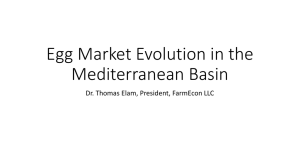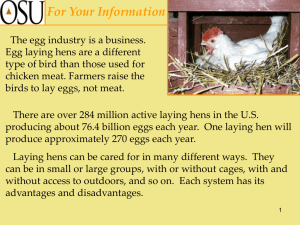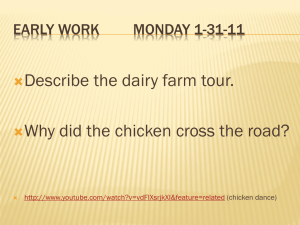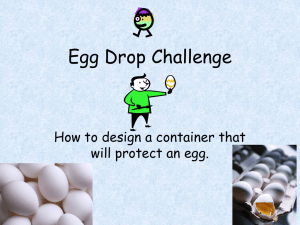Poultry Evaluation
advertisement
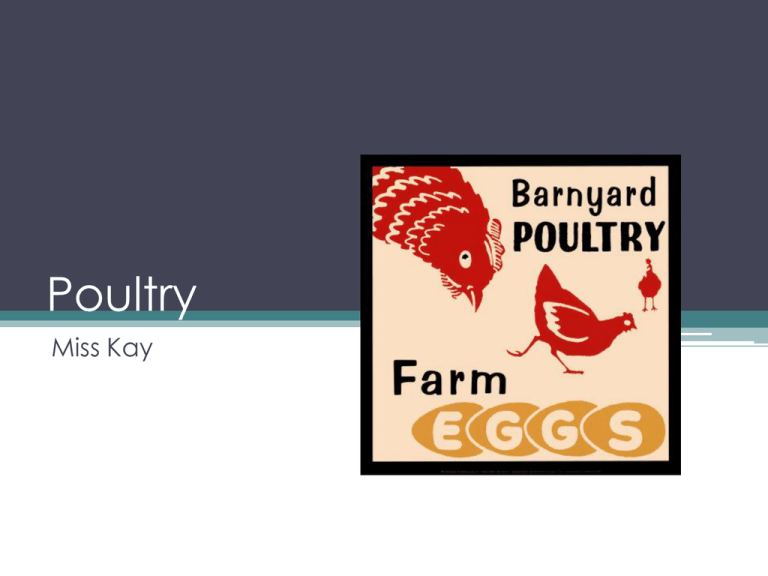
Poultry Miss Kay What An Ideal Chicken! • Techno Chicken Objectives • Define poultry terms. • Differentiate between a productive hen and a non- laying hen • Identify parts of a chicken. • Evaluate eggs. Basic Terms • Scientific Name: Galine • Chick: Newborn chicken • Pullet: Young, immature female chicken less than 5-6 months of age • Hen: Mature female chicken • Rooster: Mature male chicken • Roaster: male or female chicken 3-5 months of age and raised for the production of meat More Terms • Capon: Castrated male chicken • Layer: Hen used for laying eggs • Broiler/Flyer: Chickens grown for meat production • Group Name: Flock • Candling: examining a shell egg’s content by holding it between one’s eye and a light source • Clutch: Nest of eggs More Terms • Egg: hard- shelled; reproductive body produced by a bird • Green: description of chicks that have recently hatched • Axial feather: short wing feather that separates primaries from secondaries • Molt: To shed feathers periodically • Oviposition: laying of an egg by a bird • Plumage: Feathers of a bird Egg- Type Hens • Characteristics to look for when examining hens: Bleaching of yellow pigment in the shanks, feet, and beak Condition and capacity of the abdomen Condition of plumage and rate of molt of the wing primaries Vigor and vitality Head characteristics Bleaching of Body Pigment • Order that the body pigment fades: ▫ ▫ ▫ ▫ ▫ ▫ ▫ ▫ Vent Eye Ring Earlobe Base of Beak Tip of Beak Bottom of Foot Shank Hock and Tip of Toe Bleaching of Body Pigment • Hens that show signs of returning pigment are decreasing in egg production • Pigment returns to the body parts in the same order it faded ▫ Returns 3 times quicker ▫ Four factors: Amount of pigment in feed Health and vitality of hen Whether the hen is confined or not Size and coarseness of the hen Condition and Capacity of Abdomen • Good indicator of egg production ▫ Abdomen of a layer is wide, soft (lacks fat), and expanded ▫ Pelvic bones are thin and flexible ▫ Vent is moist, large, and oblong in shape • Non-layer ▫ Narrow, hard (fatty), and contracted ▫ Pelvic bones are thick and rigid ▫ Vent has some moistness but is small and round in shape Abdominal Capacity • Abdominal capacity of a hen is measured and expressed by ones fingers width. ▫ Normal- 3 fingers width by 4 fingers width Plumage and Rate of Molt • Two factors considered in appraising the plumage of hens include condition (feather appearance) and molting rate (speed of shedding feathers) Vigor and Vitality • A high producing hen appears vigorous, alert, and quick in movement • Non-producing hen is sluggish Head and Head Parts • If not trimmed- a productive hen’s beak is short ▫ The hens eyes are bright, alert and round. ▫ Her skull is flat from side to side ▫ Her comb and wattles are large, bright red, and glossy ▫ They feel velvety soft and warm when touched. • Non-producing hens beak is long ▫ The hens eyes are dull, sleepy, and oblong. ▫ Her skull is rounded from side to side ▫ Her comb and wattles are shrunken and dull ▫ They feel rough and cool when touched Parts of A Chicken Who can come up here and label the parts of a chicken? Wing Comb and Wattles Comb Wattles Hock, Shank, And Feet Vent Crop Parts of a Chicken Eggs Egg and Its Parts Egg Dissection? • Would you want to look inside of the egg? • How can we look at the contents inside? ▫ Why is it important to look at the contents inside? • What is the process called that allows us to look inside the egg? Candling Eggs • Candling Demo • What do we look for when we candle eggs? ▫ ▫ ▫ ▫ Air Cell Yolk Cracks in shell Blood spots and other foreign matter Before We Candle Eggs Air Cell Yolk • Temperature- 105 degrees • Is normally at the large end of the egg • Quality Grades: ▫ AA- up to 1/8” ▫ A- 1/8”-3/16” ▫ B- > 3/16” • Yolk size and shape • Distinctness of yolk shadow outline • Yolk defects and germ development What Does Your Egg Look Like? Objectives • Define poultry terms. • Differentiate between a productive hen and a non- laying hen • Identify parts of a chicken. • Evaluate eggs. Now… GAMETIME!!! We are playing What is the scientific name of poultry? What is this part of the chicken called? What Grade will the egg have if it has up to a 1/8” air cell? Do chickens gain pigment quicker than losing it or do chickens lose pigment quicker than gaining it? What is this part of the chicken called? What is this part of the chicken called? What is this process called? What part of the egg is this? What is the name of the pigment found in the chicken? What is this part of the chicken called? What is this part of the chicken called? What is this part of the chicken called? What is a layer? What type of feathers are these? What do we look for when we candle eggs? What are the top 3 areas that molt? What part of the egg is this? What Grade will the egg have if it has greater than 3/16” air cell? What is this part of the chicken called? Name 3 body parts that fade in pigment. What is the temperature of an egg when it is laid? Name 2 characteristics that we look for when examining hens. What is this breed of chicken? Where is the air cell found in the egg? What is a pullet? How many times faster does pigment gained then lost? What part of the egg is this? What is a broiler? What is candling? What is this part of the chicken called? What Grade will the egg have if it has 1/8”- 3/16” air cell? What is this type of feather? How is the abdominal cavity on a hen measured? What type of feathers are these? What is the normal measurement of the abdominal capacity? What part of the egg is this? What is plumage? What is Oviposition? What is this part of the chicken called? What does “green” mean? Name one characteristic about the head of a hen that shows that it is a productive hen. Name one of the things we look for when evaluating yolk. What is this called?

